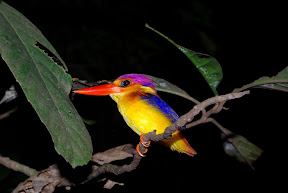
26-July - 29-July 2010
Four days ago we set out on boat along the mighty Kinabatangan River. The river is the color of chocolate milk, fed by runoff from the daily rains. Its banks are covered in lush forests with the eyes of numerous creatures big and small peering out at visitors as they motor past. However the forests along the Kinabatangan are a battleground where Malaysia’s growing economy and the rainforest are in constant conflict. From our narrow perspective the dark side seems to have the upper hand. In many places the rainforest is a mere strip of trees no more than 50 feet wide lining the river bank, in others the palm oil plantations (take a tour of your cupboard and I bet you can find plenty of palm oil in ingredients lists) have advanced straight to the river’s edge, and in others the trunks of large trees are stacked waiting for the logging boat to take them to market. In far too few places the forest has been untouched and remains in large continuous swathes. That said, the Kinabatangan is a magical place and the four days we spent at Uncle Tan’s jungle camp is sure to be one of the highlights of our trip.
Shortly after embarking on our trip up the river we came across a large troop of long-tailed macaques – the “cheeky monkey”-- lounging on a sand bar and cavorting in the trees. Over the course of the next few days sightings of these playful creatures would become so frequent that they would almost go unnoticed. Nearly everyone who visits the Kinabatangan hopes to catch a glimpse of a wild orangutan. At one time orangutans were abundant on the islands of Borneo and Sumatra, but now they are rare and endangered. Luck was on our side as our boat diver and cheerful guide swerved rapidly and put the brakes on the outboard motor, “Orangutan!” With our hearts in our throats we watched as three (2 adults and one baby) of these great apes moved through the canopy of a nearby tree. Spectacular!
Nearing sundown we made our way to Uncle Tan’s. The jungle camp is far from luxurious (just mattresses on the floor of wooden huts covered by mosquito nets, no running water, limited electricity-you get the picture) but it is very comfortable. The food was excellent and the camp staff was superb. In fact, the folks working in the camp must be some of the happiest people on earth. Each day we were greeted with smiles, friendliness, morning soccer (on a small sand field) and volleyball games, endless song and guitar music, and, at night, a big pail of “monkey juice” passed around to add to the merriment. These guys love the jungle and love to have a good time!
During our stay we participated in 7 boat safaris, and 3 jungle walks, which took place day and night. Sightings ranged from the fleeting glance of proboscis monkeys (a rare, Borneo endemic) leaping through the trees at sundown to a techni-colored kingfisher perched mere inches from us on a branch during our night walks (which our guide teased was a plastic bird he had placed there hours before) to countless flyovers by beautiful and charismatic oriental pied hornbills. The haunting calls of the Borneo gibbons (another primate) and their amazing speed as they swung from tree to tree will be unforgettable. The highlights of the trip occurred bright and early during the 6:30am river safaris on days three and four. On both days we had the great fortune to watch a single female orangutan feeding on fig fruit in a tree above us no more 20-30 feet away. The experience of watching these close human relatives in the wild was surreal (our DNA varies by only about 3%). All in all, we saw 6 primate species, numerous birds, lizards, frogs, crocodiles, and countless insects (see below for the complete list) during our trip.
Sitting here gazing at the mist shrouded foothills of Mt. Kinabalu we already miss the Kinabatangan. The lowland forest of Borneo, home to orangutans and countless other creatures, is an enchanting place that literally breathes biodiversity. As botanists, conservationists and lovers of nature, this habitat will hold a special place in our hearts. The Kinabatangan exists at a crossroads. Only time will tell what the future holds for Borneo’s orangutans, proboscis monkeys and gibbons.
A Partial List of What We Saw
Mammals
Borneo gibbon (seen 3 times)
Flying squirrel
Orangutan (seen 4 times, 6 individuals)
Palm civet
Pig-tailed macaque
Plant pygmy squirrel
Proboscis monkey
Long-tailed macaque
Silver leaf monkey
Birds (not an exhaustive list-we are, by no means, birders)
Bee-eaters
Black-backed kingfisher
Black and red broadbill
Blue-eared kingfisher
Crested serpent eagle
Little pied flycatcher
Oriental pied hornbill
Owls
Red fish eagle
Stork-billed kingfisher
White-bellied fish eagle
Reptiles and Amphibians
Comb-crested agamid lizard
Grass frog
Frogs (at least 4 other species)
Monitor lizard
Other lizards and skinks
Saltwater crocodile



